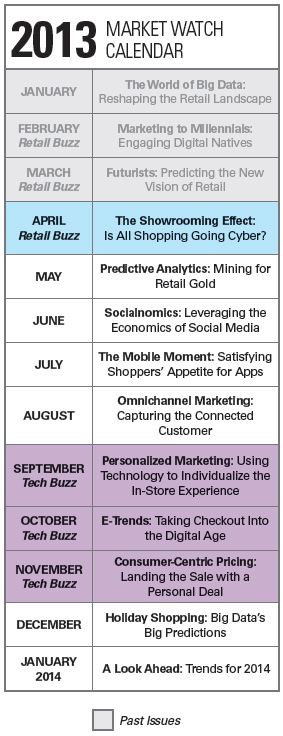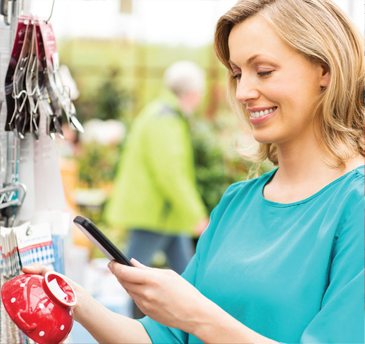“Will ‘showrooming‘ kill businesses?” – CNN
 It seems everywhere you turn there is yet another headline questioning whether traditional retail stands on the brink of extinction due to the rise of showrooming. And it’s not hard to see how the practice of visiting a brick-and-mortar store to try out a product before ultimately purchasing it through an online merchant got its start. As humans, we have an innate need to see, hear, smell, feel and manipulate objects in our physical world. Being able to see the brightness of the screen and listen to the sound quality of a TV, smelling the fragrance and feeling the creaminess of a face lotion, testing the softness of a sweater against the skin—that’s what drives shoppers into the brick-and-mortar store. The real question is what then drives the over 40 percent of shoppers reported to engage in showrooming away from the physical store and onto the virtual sales floor? According to recent studies by Aprimo and Northwestern University, many leave because of poor customer service, lack of personalization and items that are a higher cost and lower value. However, retailers and CPGs have the opportunity to overcome all three of these by rethinking and reinventing the in-store experience.
It seems everywhere you turn there is yet another headline questioning whether traditional retail stands on the brink of extinction due to the rise of showrooming. And it’s not hard to see how the practice of visiting a brick-and-mortar store to try out a product before ultimately purchasing it through an online merchant got its start. As humans, we have an innate need to see, hear, smell, feel and manipulate objects in our physical world. Being able to see the brightness of the screen and listen to the sound quality of a TV, smelling the fragrance and feeling the creaminess of a face lotion, testing the softness of a sweater against the skin—that’s what drives shoppers into the brick-and-mortar store. The real question is what then drives the over 40 percent of shoppers reported to engage in showrooming away from the physical store and onto the virtual sales floor? According to recent studies by Aprimo and Northwestern University, many leave because of poor customer service, lack of personalization and items that are a higher cost and lower value. However, retailers and CPGs have the opportunity to overcome all three of these by rethinking and reinventing the in-store experience.
Improving Customer Service
Retail is above all a service industry, and every associate—from the stock clerk to the cashier to the store manager—has a critical role to play in satisfying shoppers’ needs and expectations. “Robust customer experiences hinge on positive interactions with in-store sales associates,” states Dr. Gary Edwards, Chief Customer Officer at Empathica, in a recent interview with Retail Touchpoints. “But just 38 percent of consumers are left with the perception that big box retail employees enjoy their work, revealing serious concerns about the impact employee attitudes are having on the brick-and-mortar experience.”
Creating a culture centered on customer service is clearly a must for retailers. But it’s more than just implementing a policy. The first step comes in hiring associates who love what they do and who enjoy working with the public. With the right people in place, activities like welcoming shoppers into the store (warmly and in a way that goes beyond the superficial “welcome to X” greeting), asking if they need help and offering to walk them to the aisle that contains the item they’re trying to find will come naturally. Ongoing training, recognition and incentives (be they tangible or intangible) are often the key to creating this culture of service—and are a worthwhile investment given that good service is often rewarded with sales.
Personalizing the Shopping Experience
As noted by David Shulman, CEO for digital marketing agency Organic, in an interview with MarketingVox.com, “There might be a race to the bottom in pricing, but it’s still a race to the top in experience.” Though good service is an important factor in creating a positive shopping experience, it is not all that is required. Associates also need robust training on the products they sell. Unlike online reviews or static product descriptions, a well-trained associate can talk with shoppers one-on-one, answering questions and providing in-depth insight that directly combats the lack of information many have cited as a reason for turning to the web, as well as the one-size-fits-all approach served up by many online retailers.
-David Shulman, CEO of Organic
Adding a retailer-branded in-store sampling and demonstration event program run by an experienced event marketing company into the mix can further the positive, personalized shopping experience, while also playing to shoppers’ tactile instincts. These events actively encourage shoppers to get hands-on with a product by engaging all five senses, as well as shoppers’ emotions. They also give event demonstrators the opportunity to show how the product can serve each shopper’s unique needs. When a shopper shows interest, demonstrators can use the relationship they’ve begun to establish to directly ask for the sale, handing over a package or personally guiding the shopper to the shelf where the product can be found. All of these techniques deliver a shopping experience that makes the customer feel valued, which can be the difference between a finalized sale and yet another opportunity lost to the virtual retail world.
Providing Value
 Addressing customer service and personalization issues by elevating the in-store experience is a natural fit. But what about cost concerns? Here, a lesson can be learned from retailers like Costco and Target. These industry leaders are beginning to work with vendors and CPGs to change the in-store/online value dynamic by offering exclusive, upgraded versions of products. Shoppers are being enticed with special offers, such as a coffee maker bundled with a reusable filter that would normally cost double the difference in price between the base model available online and this exclusive in-store-only bundle. But it’s not enough to simply put these products on the shelf—you also have to get customers to buy into the value-add concept. Associates or dedicated brand ambassadors (think a “KitchenAid® Specialist” or “Kellogg’s® Guru”) can be the answer. These product experts can highlight product attributes, making the differences and added value clear to shoppers, while also appealing to their emotions by making them feel like they’re getting something truly special and unique that’s only available in-store and not online.
Addressing customer service and personalization issues by elevating the in-store experience is a natural fit. But what about cost concerns? Here, a lesson can be learned from retailers like Costco and Target. These industry leaders are beginning to work with vendors and CPGs to change the in-store/online value dynamic by offering exclusive, upgraded versions of products. Shoppers are being enticed with special offers, such as a coffee maker bundled with a reusable filter that would normally cost double the difference in price between the base model available online and this exclusive in-store-only bundle. But it’s not enough to simply put these products on the shelf—you also have to get customers to buy into the value-add concept. Associates or dedicated brand ambassadors (think a “KitchenAid® Specialist” or “Kellogg’s® Guru”) can be the answer. These product experts can highlight product attributes, making the differences and added value clear to shoppers, while also appealing to their emotions by making them feel like they’re getting something truly special and unique that’s only available in-store and not online.
The bottom line is that retailers and CPGs need to vary the lens through which they view their marketing efforts. In the past, getting shoppers into the store was often the primary focus. But the fact that showroomers are going to brick-and-mortar stores first and still leaving empty handed is evidence that simply getting shoppers in the door isn’t enough. It’s also proof that virtual retailers can’t satisfy shoppers’ every need. To overcome the showrooming phenomenon, retailers and CPGs must work to fill in the gaps left by online shopping and provide an in-store experience that shoppers value—both emotionally and financially.

